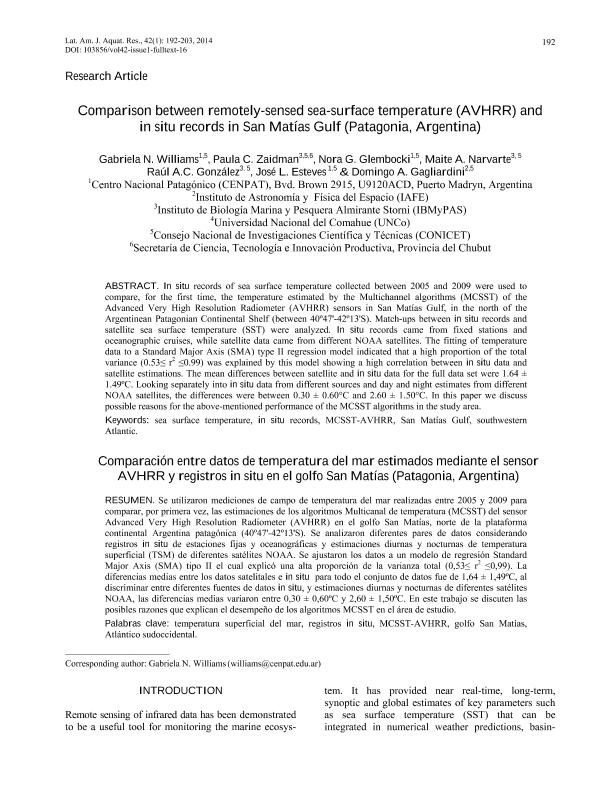Artículo
In situ records of sea surface temperature collected between 2005 and 2009 were used to compare, for the first time, the temperature estima ted by the Multichannel algorithms (MCSST) of the Advanced Very High Resolution Radiometer (AVHRR) sensors in San Matías Gulf, in the north of the Argentinean Patagonian Continental Shelf (between 40º47'-42º13'S). Match-ups between in situ records and satellite sea surface temperature (SST) were analyzed. In situ records came from fixed stations and oceanographic cruises, while satellite data came from di fferent NOAA satellites. The fitting of temperature data to a Standard Major Axis (SMA) type II regression model indicated that a high proportion of the total variance (0.53 ≤ r 2 ≤ 0.99) was explained by this model showing a high correlation between in situ data and satellite estimations. The mean differences between satellite and in situ data for the full data set were 1.64 ± 1.49ºC. Looking separately into in situ data from different sources and day and night estimates from different NOAA satellites, the differences were between 0.30 ± 0.60°C and 2.60 ± 1.50°C. In this paper we discuss possible reasons for the above-mentioned performan ce of the MCSST algorithms in the study area. Se utilizaron mediciones de campo de temperatura del mar realizadas entre 2005 y 2009 para comparar, por primera vez, las esti maciones de los algoritmos Multicanal de temperatura (MCSST) del sensor Advanced Very High Resolution Radiometer (AVHRR) en el golfo San Matías, norte de la plataforma continental Argentina patagónica (40º47'-42º13'S). Se analizaron diferentes pares de datos considerando registros in situ de estaciones fijas y oceanográficas y estimaciones diurnas y nocturnas de temperatura superficial (TSM) de diferentes saté lites NOAA. Se ajustaron los datos a un modelo de regresión Standard Major Axis (SMA) tipo II el cual explicó una alta proporción de la varianza total (0,53 ≤ r 2 ≤ 0,99). La diferencias medias entre los datos satelitales e in situ para todo el conjunto de datos fue de 1,64 ± 1,49ºC, al discriminar entre diferentes fuentes de datos in situ , y estimaciones diurnas y nocturnas de diferentes satélites NOAA, las diferencias medias variaron entre 0,30 ± 0,60ºC y 2,60 ± 1,50ºC. En este trabajo se discuten las posibles razones que explican el desempeño de los algoritmos MCSST en el área de estudio.
Comparison between remotely-sensed sea-surface temperature (AVHRR) and in situ records in San Matías Gulf (Patagonia, Argentina)
Título:
Comparación entre datos de temperatura del mar estimados mediante el sensor AVHRR y registros in situ en el golfo San Matías (Patagonia, Argentina)
Williams, Gabriela Noemí ; Zaidman, Paula Cecilia
; Zaidman, Paula Cecilia ; Glembocki, Nora Gabriela
; Glembocki, Nora Gabriela ; Narvarte, Maite Andrea
; Narvarte, Maite Andrea ; González, Raul Alberto Candido
; González, Raul Alberto Candido ; Esteves, Jose Luis
; Esteves, Jose Luis ; Gagliardini, Domingo Antonio
; Gagliardini, Domingo Antonio
 ; Zaidman, Paula Cecilia
; Zaidman, Paula Cecilia ; Glembocki, Nora Gabriela
; Glembocki, Nora Gabriela ; Narvarte, Maite Andrea
; Narvarte, Maite Andrea ; González, Raul Alberto Candido
; González, Raul Alberto Candido ; Esteves, Jose Luis
; Esteves, Jose Luis ; Gagliardini, Domingo Antonio
; Gagliardini, Domingo Antonio
Fecha de publicación:
2014
Editorial:
Pontificia Universidad Catolica de Valparaíso. Facultad de Recursos Naturales. Escuela de Ciencias del Mar
Revista:
Latin American Journal of Aquatic Research
ISSN:
0718-560X
Idioma:
Inglés
Tipo de recurso:
Artículo publicado
Clasificación temática:
Resumen
Archivos asociados
Licencia
Identificadores
Colecciones
Articulos(CCT-CENPAT)
Articulos de CTRO.CIENTIFICO TECNOL.CONICET - CENPAT
Articulos de CTRO.CIENTIFICO TECNOL.CONICET - CENPAT
Articulos(IAFE)
Articulos de INST.DE ASTRONOMIA Y FISICA DEL ESPACIO(I)
Articulos de INST.DE ASTRONOMIA Y FISICA DEL ESPACIO(I)
Citación
Williams, Gabriela Noemí; Zaidman, Paula Cecilia; Glembocki, Nora Gabriela; Narvarte, Maite Andrea; González, Raul Alberto Candido; et al.; Comparison between remotely-sensed sea-surface temperature (AVHRR) and in situ records in San Matías Gulf (Patagonia, Argentina); Pontificia Universidad Catolica de Valparaíso. Facultad de Recursos Naturales. Escuela de Ciencias del Mar; Latin American Journal of Aquatic Research; 42; 1; -1-2014; 192-203
Compartir



